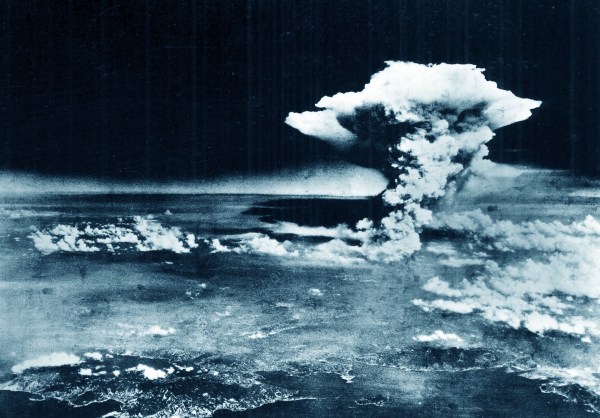“The man who is ready to prove that metaphysical knowledge is wholly impossible has no right here to any answer … since he himself has, perhaps unknowingly, entered the arena. He is a brother metaphysician with a rival theory of first principles.”
F. H. Bradley
Appearance and Reality: A Metaphysical Essay, 1893
Christians do well to remind ourselves from time to time that our God was the Jews’ before He was ours, and if we believe, as our philosophy teaches us to believe, that His perfection implies a nature that is eternally unchanging, then the Father to whom our humble and meek Jesus reconciles us is the God of the great flood, the God of the horrible plagues inflicted on the Egyptians—not only on Pharaoh and his captains but on the civilians, on the women and, most infamously, on the children—the God who rained fire on Sodom, who cruelly tested Abram, who commanded the genocide of the Canaanites, the God afflicted with that most tedious of human failings: the God who is, by His own account, jealous.
To serve Him is a little like how Thomas More (as imagined by Hilary Mantel) described intimacy with a king: “It’s like sporting with a tamed lion. You tousle its mane and pull its ears, but all the time you’re thinking, those claws, those claws, those claws.”
The God of the Israelites wants us to understand some things about His character, the most important of which is (judging by His especial fury when confronted with idolatry) that He is not a thing, that He is not part of the physical world. He isn’t a statue, or a mountain, or a special tree. He does have a special connection with a certain people—formerly an obscure tribe of semi-nomadic desert herders—and with certain places and structures (His temple must be in such-and-such a place, with such-and-such a construction), with a certain city (Jerusalem) and a certain hill (grandly called “Mount” Zion). He even feels it necessary from time to time to manifest Himself in physical form, as a pillar of fire or a cloud of glory or—the moment at which Christians depart from our elder brothers in the faith—in the person of an obscure Galilean exorcist and religious dissident put to death in an especially grim and undignified way by Roman colonial overlords with the collaboration of the local religious authorities. If God were not omnipotent, we might say that He is entangled with the physical world in some incomprehensible way, linked to us by “spooky action at a distance,” as Albert Einstein famously described a different kind of inexplicable entanglement.
But, of course, He is not entangled.
Maybe it would be best to describe God as interested in the physical world, as a respecter of its character and its processes. (This is one of the many reasons that Christian objections to conventional accounts of the facts of life given by physics and biology—and the attempt to construct a pale parallel system contributing nothing to the sum of human knowledge and having as its sole virtue the fact that it is less disturbing to the mental calm of Sunday school teachers—has always seemed to me particularly foolish, however well-intentioned.) It does not do to try to read His mind, but, presumably, He created a physical world for a reason, though it may be an oversimplification to say that He has reasons at all. But He created a physical world. For the Christian, the most important fact in the history of creation is that God chose to work out the difficulties in His relationship with His fallen creatures in this world, in its blood and excrement and grief, in the dangers of pregnancy and in the agony of childbirth, subject to all of human life’s pain and dangers, including the menace of the arbitrary political power that put the incarnate God to shame, torture, and death.
In the closing days of the grotesque and bloodthirsty Anno Domini 2023, Christians might meditate for an evening on the fact that—assuming we are right about the things we believe ourselves to be right about—our salvation was worked out in the Jewish flesh of a Jewish man born of a Jewish mother, and that this Jewish flesh still survives, somehow, having endured death and then bested it before being assumed, body intact, into what we call, for lack of a better term, Heaven or Paradise or Eternity. If we Christians really believe our own dogma, then it is wrong to say, “Jesus was a Jew.”
Not was, but is.
“Before proceeding further we may conveniently pause at this point,” professor Bradley continues in his Appearance and Reality. “The reader may be asked to reflect whether anything of what is understood by a thing is left to us. It is hard to say what, as a matter of fact, is generally understood when we use the word ‘thing.’ But, whatever that may be, it seems now undermined and ruined. I suppose we generally take a thing as possessing some kind of independence, and a sort of title to exist in its own right, and not as a mere adjective. But our ideas are usually not clear. A rainbow probably is not a thing, while a waterfall might get the name, and a flash of lightning be left in a doubtful position. Further, while many of us would assert stoutly that a thing must exist, if at all, in space, others would question this and fail to perceive its conclusiveness.”
We remember them by the things they brought, these supposed wise men from the East, the wisdom of whom surely was not immediately apparent to the servants and acolytes they no doubt dragged along with them to Bethlehem, supposedly following a star, supposedly called by some divine voice, supposedly to witness nothing extraordinary at all but the most ordinary thing in the world: poor people being pushed around by powerful people, forced onto the road in spite of a young woman’s very ripe pregnancy, and then made to do that other most ordinary thing in the world—give birth—in uncomfortable and undignified surroundings. This pilgrimage must have seemed to everyone else—and perhaps to the Magi themselves—utterly insane.
But pilgrims have priorities beyond seeming sane, from the Separatist pilgrims who founded this country (though they did not realize at the time that they were doing anything of the sort) to the ones who seek out holy men and holy places that almost never seem to be conveniently located.
(I once went on something that was formally a pilgrimage, and I fulfilled all of the related obligations. I also stayed in a comfortable hotel, had lunch with a cardinal who was full of fascinating gossip, and spent an afternoon looking at Caravaggios. Barefoot through the snow to Canterbury it was not.)
The gifts the Magi brought are traditionally given as gold, frankincense, and myrrh. The messianic symbolism of the first two gifts is obvious enough: gold, befitting the royalty of the “newborn king” we still sing about, frankincense reflecting His priestly character. Myrrh is a little less obvious—not in retrospect, but at the time: It was used in religious rituals, as an ingredient in anointing oil for priests and priestly implements (Moses is given a recipe in Exodus 30) and for the ritual purification of women (Esther 2 describes its use in Xerxes’ harem), but where we see it most significantly deployed is in its traditional use in preparing corpses for burial. “And there came also Nicodemus, which at the first came to Jesus by night, and brought a mixture of myrrh and aloes, about an hundred pound weight.”
The things tell the story, or at least part of it. (“Others would question this and fail to perceive its conclusiveness.”) If you visit the Duomo at Monza, you can see the Iron Crown of Lombardy, so called because of an iron band on its interior that was made, according to legend, from one of the nails used in the Crucifixion. That may not be exactly true, but, then, the Iron Crown isn’t exactly a crown, either, unless the Lombards, who were big, strapping, Germanic types, had tiny little heads. (It probably was a “votive crown,” an altar decoration. Either that or an armlet for a Lombard who did a lot of biceps curls.) The myrrh may have implied the death necessarily precedent to the Resurrection, if not the nails and the precise manner of death. The juxtaposition is almost too much to keep in the mind all at one: the tenderness and sweetness of the little boy, the brutality and the almost inhuman (but also all-too-human) cruelty of the Crucifixion. These are facts, rooted in familiar human experience, while much of the rest of the story—Jesus’s kingship and messiahship and the meaning of these—is notional, more understood than experienced. There is a vast chasm between the facts of the case—or the plausibly asserted facts—and their meaning. How we get from one side of that divide to the other is a matter of some interest.
Professor Bradley won’t mind if we peek over to the other side of the philosophical fence to A. J. Ayer’s The Elimination of Metaphysics: “Let us suppose that a picture is discovered and the suggestion made that it was painted by Goya. There is a definite procedure for dealing with such a question. The experts examine the picture to see in what way it resembles the accredited works of Goya, and to see if it bears any marks which are characteristic of a forgery; they look up contemporary records for evidence of the existence of such a picture, and so on. In the end, they may still disagree, but each one knows what empirical evidence would go to confirm or discredit his opinion. Suppose, now, that these men have studied philosophy, and some of them proceed to maintain that this picture is a set of ideas in the perceiver’s mind, or in God’s mind, others that it is objectively real. What possible experience could any of them have which would be relevant to the solution of this dispute one way or the other?”
Beyond the writings of the early Christians, we have almost no contemporary documentary evidence that Jesus existed at all. (The passage in which the historian Josephus describes Jesus as the messiah, the so-called Testimonium Flavianum, is almost certainly a later addition, i.e., a forgery.) But, then, we had almost no evidence that Pontius Pilate existed, either—and no contemporary evidence—until the discovery of a first-century inscription including his name in 1961. It is easy to imagine, however, that such-and-such a man lived at such-and-such a time and place, that he taught this and that, that he did, or was thought to have done or was said to have done, seemingly miraculous things. Jesus the man, the teacher, the real or supposed miracle-worker—that Jesus is comprehensible. Even if we did not meet Him while He walked the Earth, we have met other men of that kind. It is the Jesus who stands on the other side of Incarnation, outside of the realm of physical fact and experience, Who is incomprehensible to us. If we follow professor Ayer’s advice, then we might conclude that this is a case to which we should apply Wittgenstein’s maxim: “Whereof one cannot speak, thereof one must be silent.”
There is wisdom in that advice. Silence very often is the wisest choice. But there also is a time to speak, to tell the story.
But it is a perplexing story. It is a story that chases its own tail: boyhood, manhood, godhood. The little family, the little boy who grows into the remarkable man, the gold and the frankincense and the myrrh, the cross and the nails, the empty tomb, the wine and the bread, the Roman prefect and his entourage—the well-meaning Christian (even if not of an especially skeptical bent), to say nothing of the overwhelmed and perhaps wearied nonbeliever, might well ask: Was all of that, strictly speaking, necessary? Does the achievement of God’s purposes really require all that great, unwieldy accumulation of things, of people and events, of particularities? Was it really necessary for the Creator of the Universe, not subject to time and space but sovereign over them, to intervene in history in this radically unlikely way? If He could speak the world into being, could He not also simply speak it into good order? Eternal, omnipotent, incorporeal: Why all the blood and guts, anyway?
I am not the first to ask these questions: There are libraries full of books addressing them. The weirdness and implausibility of it all was very much on the minds of the men and women who knew Jesus personally, while He was physically present among us—that the story would seem foolish was apparent not least to Jesus, if we take Scripture at its word. As the irascible St. Paul put it, “God hath chosen the foolish things of the world to confound the wise, and God hath chosen the weak things of the world to confound the things which are mighty,” a passage that Christians are very fond of quoting as though it answered something—which, if you reread it, you’ll notice that it doesn’t.
If we believe what we say we believe about God, that He is omnipotent, then this unlikely series of events resulting in the utterly implausible and obviously unverifiable claims made by Christians in Anno Domini 2023 is, whatever it is, probably not the best He could do. More probably, it is the best we can do. You could put on a great performance of Coriolanus for an audience of dachshunds, but they aren’t going to get it, and they’ll respond better to other stimuli. He meets us on our own terms because we cannot meet Him on His. We understand the sweetness and the vulnerability of the little Jewish boy, the fear of the young Jewish mother, the uneasiness of the Jewish father, and we share their familiarity with the terrors of the body, uncertain physical security, the brutality of political violence, the wider world’s indifference to these people in their little nation of no obvious special significance. We understand the myrrh only because we are so intimately familiar with the stink of death. And if we are there in the shelter of the stable, there with the young family and the strange benefactors and their exotic gifts and the love that connects them all, then we were there at the other place, too. The Magi didn’t have to bring the nails—we did, and it was only as we took up the spear at the very last that we understood the great and terrible beauty of what it meant—what it means—for Him to be Emmanuel, God With Us, not in a mental picture or in a religious theory but here, in the real world, in the blood and the tears and the dirt. Here where He found us, in the darkness, between the black seas and the red desert, with our meager gifts and uncomprehending eyes, all of us pilgrims far from home.







Please note that we at The Dispatch hold ourselves, our work, and our commenters to a higher standard than other places on the internet. We welcome comments that foster genuine debate or discussion—including comments critical of us or our work—but responses that include ad hominem attacks on fellow Dispatch members or are intended to stoke fear and anger may be moderated.
With your membership, you only have the ability to comment on The Morning Dispatch articles. Consider upgrading to join the conversation everywhere.